
| Version | Summary | Created by | Modification | Content Size | Created at | Operation |
|---|---|---|---|---|---|---|
| 1 | Ajit Behera | -- | 4317 | 2022-09-01 03:29:55 | | | |
| 2 | Vivi Li | + 22 word(s) | 4339 | 2022-09-01 03:51:31 | | | | |
| 3 | Vivi Li | Meta information modification | 4339 | 2022-09-09 11:36:45 | | |
Video Upload Options
Brackets are the load-bearing components in a satellite. The current age of satellites comprises specific brackets that set out as a link between the bodies of the satellite, reflector parts, and feeder facilities mounted at its upper end. Brackets are used to carry loads of the satellite body frame, supporting elements, batteries, and electronic goods. Additive Manufacturing (AM) is a process in which a 3D solid object is built by adding the material layer-over-layer. The success of making the product using AM technology requires greater experience in Design for Additive Manufacturing (DFAM) which makes use of the design of freedom of AM. Owing to the various advantages of AM and DFAM, it is easy to create high strength-to-weight ratio products. This is an important contribution to aerospace industries in meeting the unabated demand for lightweight and strong structural applications.
1. Introduction
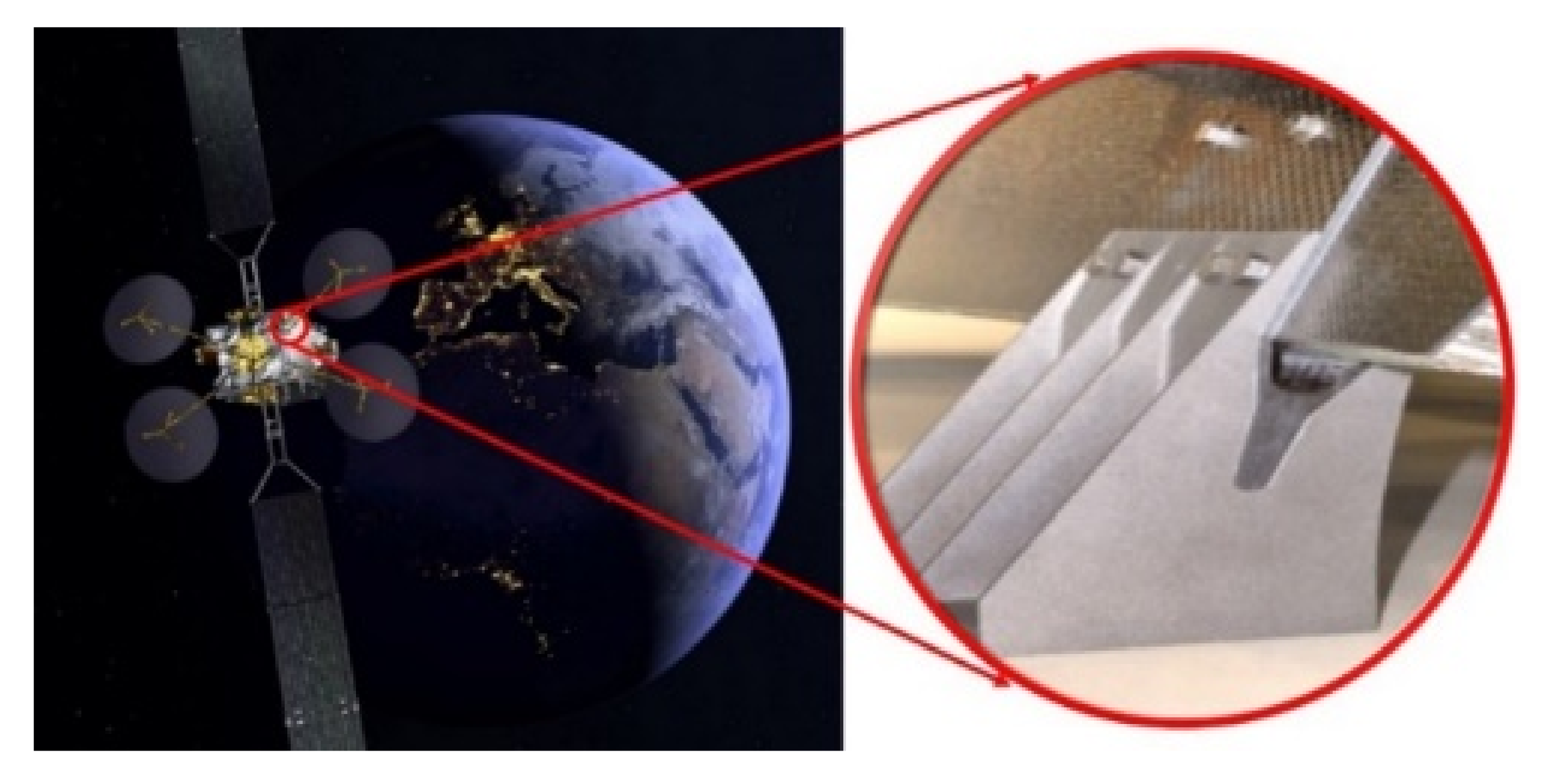
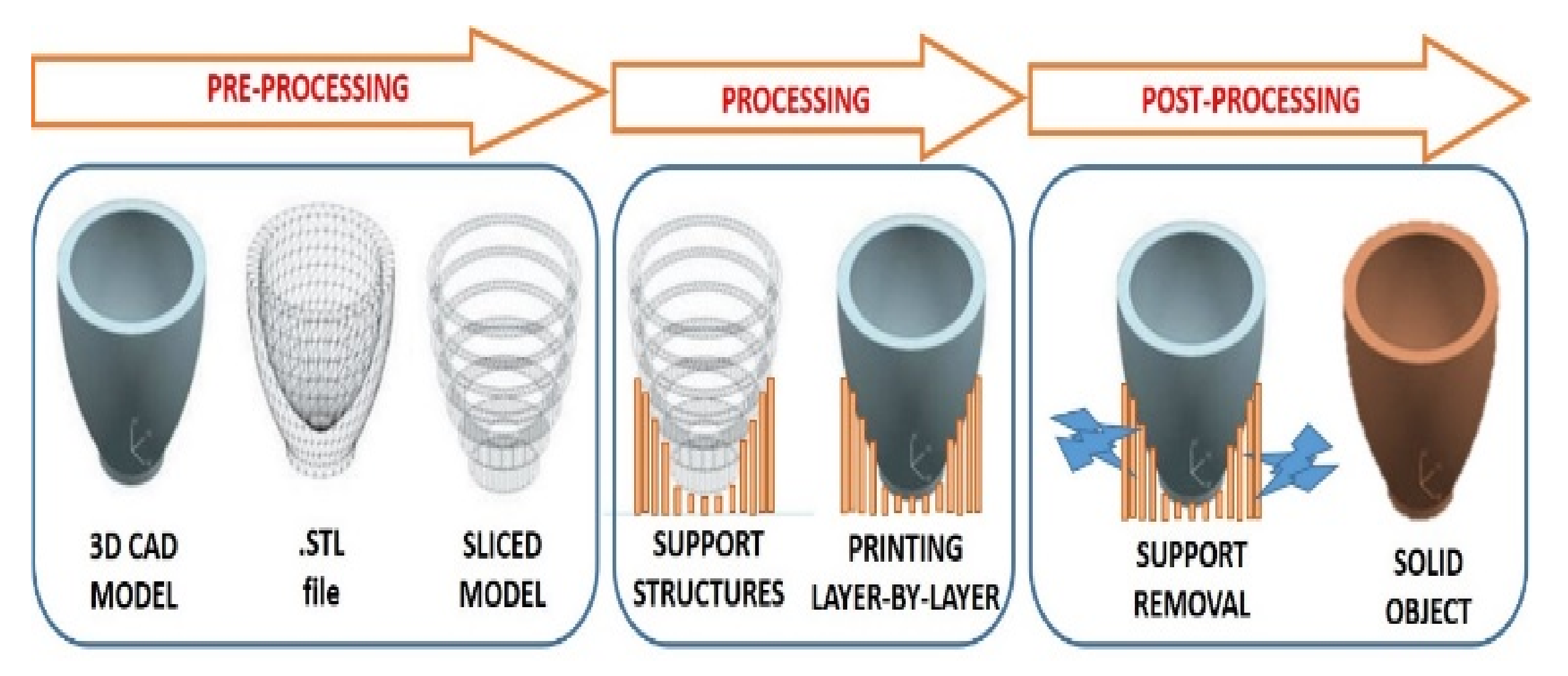
- (I)
-
Omission of smaller part assembly: During the designing procedure, various smaller parts can be replaced by a single part which allows researchers to print the complete part at once. Whereas in traditional manufacturing; first, all the components are manufactured individually and then assembled to create the final part [13].
- (II)
-
Minimization of Material waste: Advanced software like topology optimization calculates the best shape for a part and removes unnecessary material without compromising the structural integrity. This helps engineers to design and produce a lightweight part by advancing the material distribution, which leads to minimizing material waste. For example, Siemens uses generative design software in 3D printing to develop its gas turbine blades. General Motors also uses 3D printing with generative design and topology optimization software, and it aims to reduce the weight of a vehicle by exploring various options for material distribution within a component [14].
- (III)
-
Can easily create highly complex parts: AM overcomes most of the traditional manufacturing limitations to create almost every complex part with enhanced functionality. For example, the cooling channel of injection moulds in the traditional manufacturing method is mostly straight, which leads to slow and inconsistent cooling of a moulded part. The cooling channel in 3D printing is more advanced and can be re-designed according to the requirement, which provides a more homogeneous heat transfer that results in enhanced cooling characteristics [15].
- (IV)
-
Flexibility of material choice: AM process can print almost using any material available; this opens up the possibilities for material innovation. Engineers can explore the limitless option for the better properties of the product. For example, 3D printing of high-performance thermoplastics can replace some metal parts, and it is also low cost and lightweight [16].
- (V)
-
Minimized support structure: Like material innovation, 3D printing also opens up the possibility for unique support structure design. By choosing the best part orientation, the post-processing time and cost can be reduced. Though the supporting system can’t be removed completely, it is very much necessary that a minimum support system should be provided to the 3D model as it can reduce cost prominently. An optimized number of support systems should be provided while designing [17].
- (VI)
-
Lightweight product: Topology optimization provides the advantage to design and manufacture a product for a specific function, and with a made-to-measure feature, for example, unnecessary materials are removed by advanced design and complicated mathematical calculation; therefore, the product part is lightweight and cost is minimized [18].
- (VII)
-
Multimaterial Products can be manufactured: Another crucial advantage of 3D printing is multiple materials can be simultaneously printed into a solid. This solves one of the vital limitations of the conventional manufacturing method [19].
2. Materials Used in Brackets
2.1. Al-Based Alloys
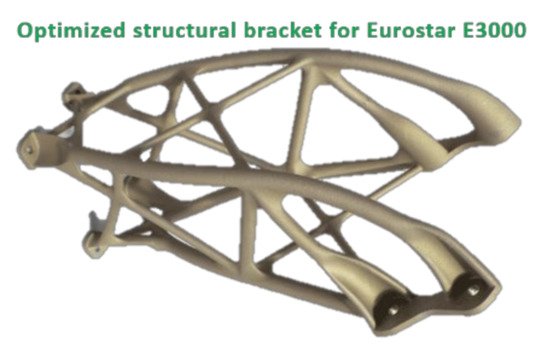
2.2. Ti-Based Alloys

2.3. Stainless Steel
2.4. NiTi-Based Alloys

3. Emerging Applications of Satellite Brackets
3.1. Antenna Brackets
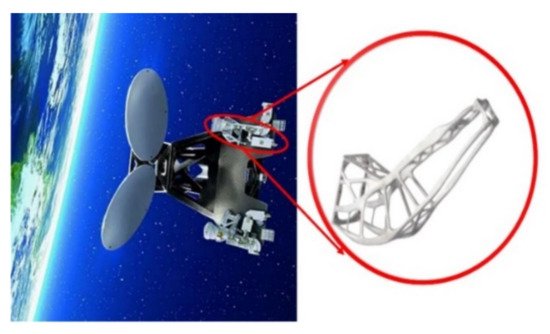
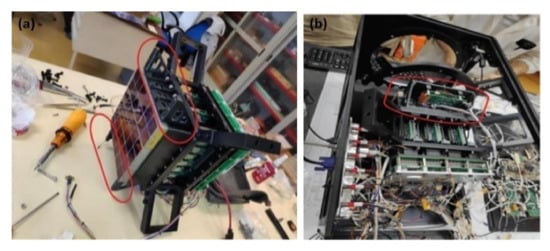
3.2. Reaction Wheel Brackets
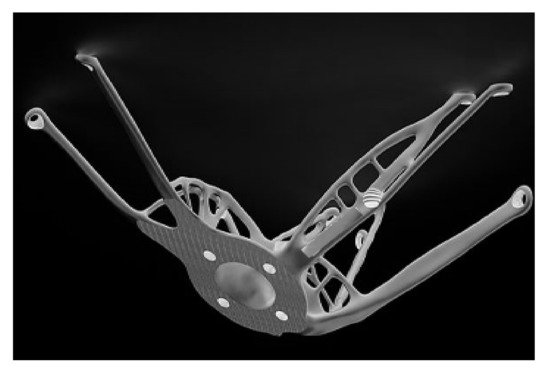
3.3. Thruster Mount Bracket
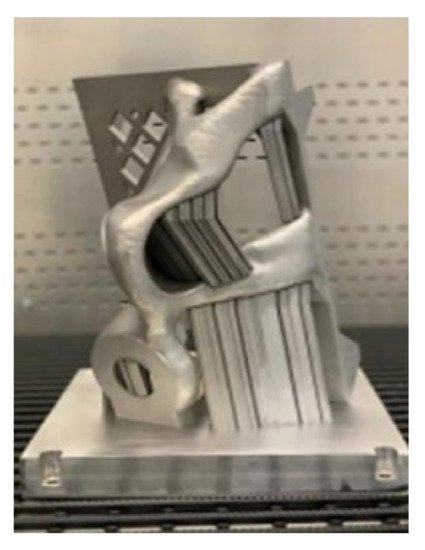
References
- Yongxin, G.; Lihua, Z.; Zhijia, L.; Yimin, G.; Ling-xi, M. Optimization Design of Star Tracker Bracket of Small Satellite for 3D Printing. In Proceedings of the 2019 5th International Conference on Control, Automation and Robotics (ICCAR), Beijing, China, 19–22 April 2019; pp. 808–811.
- Haase, C.; Bültmann, J.; Hof, J.; Ziegler, S.; Bremen, S.; Hinke, C.; Schwedt, A.; Prahl, U.; Bleck, W. Exploiting Process-Related Advantages of Selective Laser Melting for the Production of High-Manganese Steel. Materials 2017, 10, 56.
- Orme, M.; Madera, I.; Gschweitl, M.; Ferrari, M. Topology Optimization for Additive Manufacturing as an Enabler for Light Weight Flight Hardware. Designs 2018, 2, 51.
- Sinha, A.; Swain, B.; Behera, A.; Mallick, P.; Samal, S.K.; Vishwanatha, H.M.; Behera, A. A Review on the Processing of Aero-Turbine Blade Using 3D Print Techniques. J. Manuf. Mater. Process. 2022, 6, 16.
- Lighter Titanium Aerospace Part. Available online: https://www.materialise.com/en/cases/a-63-lighter-titanium-aerospace-part (accessed on 17 July 2022).
- Poomathi, N.; Singh, S.; Prakash, C.; Subramanian, A.; Sahay, R.; Cinappan, A.; Ramakrishna, S. 3D Printing in Tissue Engineering: A State of the Art Review of Technologies and Biomaterials. Rapid Prototyp. J. 2020, 26, 1313–1334.
- Singh, H.; Kumar, R.; Prakash, C.; Singh, S. HA-Based Coating by Plasma Spray Techniques on Titanium Alloy for Orthopedic Applications. Mater. Today Proc. 2022, 50, 612–628.
- Gibson, I.; Rosen, D.; Stucker, B. Additive Manufacturing Technologies, 2nd ed.; Springer: New York, NY, USA, 2015; ISBN 978-1-4939-2112-6.
- Korotchenko, A.Y.; Khilkov, D.E.; Tverskoy, M.V. The Development of New Materials and Modes of Casting Metal Powder Mixtures (MIM Technology). Mater. Sci. Forum 2019, 945, 538–542.
- Ramanath, H.S.; Chua, C.K.; Leong, K.F.; Shah, K.D. Melt Flow Behaviour of Poly-ε-Caprolactone in Fused Deposition Modelling. J. Mater. Sci. Mater. Med. 2008, 19, 2541–2550.
- Singh, A.; Singh, H. Metal Additive Manufacturing: From History to Applications. In Innovations in Additive Manufacturing: Springer Tracts in Additive Manufacturing; Khan, M.A., Jappes, J.T.W., Eds.; Springer International Publishing: Cham, Switzerland, 2022; pp. 3–32. ISBN 978-3-030-89401-6.
- Matias, E.; Rao, B. 3D Printing: On Its Historical Evolution and the Implications for Business. In Proceedings of the 2015 Portland International Conference on Management of Engineering and Technology (PICMET), Portland, OR, USA, 2–6 August 2015; pp. 551–558.
- Cuellar, J.S.; Smit, G.; Plettenburg, D.; Zadpoor, A. Additive Manufacturing of Non-Assembly Mechanisms. Addit. Manuf. 2018, 21, 150–158.
- Ford, S.; Despeisse, M. Additive Manufacturing and Sustainability: An Exploratory Study of the Advantages and Challenges. J. Clean. Prod. 2016, 137, 1573–1587.
- Gardan, J. Additive Manufacturing Technologies: State of the Art and Trends. Int. J. Prod. Res. 2016, 54, 3118–3132.
- Huang, Y.; Leu, M.C.; Mazumder, J.; Donmez, A. Additive Manufacturing: Current State, Future Potential, Gaps and Needs, and Recommendations. J. Manuf. Sci. Eng. 2015, 137.
- Strano, G.; Hao, L.; Everson, R.M.; Evans, K.E. A New Approach to the Design and Optimisation of Support Structures in Additive Manufacturing. Int. J. Adv. Manuf. Technol. 2013, 66, 1247–1254.
- Emmelmann, C.; Sander, P.; Kranz, J.; Wycisk, E. Laser Additive Manufacturing and Bionics: Redefining Lightweight Design. Phys. Procedia 2011, 12, 364–368.
- Bandyopadhyay, A.; Heer, B. Additive Manufacturing of Multi-Material Structures. Mater. Sci. Eng. R Rep. 2018, 129, 1–16.
- Dilberoglu, U.M.; Gharehpapagh, B.; Yaman, U.; Dolen, M. The Role of Additive Manufacturing in the Era of Industry 4.0. Procedia Manuf. 2017, 11, 545–554.
- Singh, S.; Prakash, C.; Antil, P.; Singh, R.; Królczyk, G.; Pruncu, C.I. Dimensionless Analysis for Investigating the Quality Characteristics of Aluminium Matrix Composites Prepared through Fused Deposition Modelling Assisted Investment Casting. Materials 2019, 12, 1907.
- Ruan, G.; Wang, Z.; Long, C.; Zhang, Y. A Study on Thermal Stability of Star-Sensitive Brackets Made up of Different Material Based on Precision Measurement. J. Phys. Conf. Ser. 2020, 1650, 022045.
- Ngo, T.D.; Kashani, A.; Imbalzano, G.; Nguyen, K.T.Q.; Hui, D. Additive Manufacturing (3D Printing): A Review of Materials, Methods, Applications and Challenges. Compos. Part B Eng. 2018, 143, 172–196.
- Khalid, M.Y.; Arif, Z.U.; Ahmed, W. 4D Printing: Technological and Manufacturing Renaissance. Macromol. Mater. Eng. 2022, 307, 2200003.
- Orme, M.E.; Gschweitl, M.; Ferrari, M.; Vernon, R.; Madera, I.J.; Yancey, R.; Mouriaux, F. Additive Manufacturing of Lightweight, Optimized, Metallic Components Suitable for Space Flight. J. Spacecr. Rocket. 2017, 54, 1050–1059.
- Brevault, L.; Balesdent, M.; Morio, J. Aerospace System Analysis and Optimization in Uncertainty; Springer: Cham, Switzerland, 2020; ISBN 978-3-030-39125-6.
- Booth, P.; Gilmore, J.; Lluch, E.V.; Harvey, M. Enhancements to Satellite Feed Chain Performance, Testing and Lead-Times Using Additive Manufacturing. In Proceedings of the 2016 10th European Conference on Antennas and Propagation (EuCAP), Davos, Switzerland, 10–15 April 2016; pp. 1–5.
- Zhu, L.; Li, N.; Childs, P.R.N. Light-Weighting in Aerospace Component and System Design. Propuls. Power Res. 2018, 7, 103–119.
- Al Alloys for Aerospace Applications. Available online: http://www.dierk-raabe.com/aluminium-alloys-for-aerospace-applications/ (accessed on 2 November 2021).
- Metal Additive Manufacturing: Download the Current Issue…. Available online: https://www.metal-am.com/metal-additive-manufacturing-magazine/ (accessed on 2 November 2021).
- Xia, X.; Xiao, L.; Chen, Q.; Li, H.; Tan, Y. Hot Forging Process Design, Microstructure, and Mechanical Properties of Cast Mg–Zn–Y–Zr Magnesium Alloy Tank Cover. Int. J. Adv. Manuf. Technol. 2018, 94, 4199–4208.
- Suseelan Nair, K.; Mittal, M.C. Rare Earths in Magnesium Alloys. Mater. Sci. Forum 1991, 30, 89–104.
- Aluminium Bracket for New Eurostar E3000 Satellite Platforms. Available online: https://www.metal-am.com/airbus-defence-and-space-develops-aluminium-bracket-for-new-eurostar-e3000-satellite-platforms/ (accessed on 17 July 2022).
- Benedetti, M.; Cazzolli, M.; Fontanari, V.; Leoni, M. Fatigue Limit of Ti6Al4V Alloy Produced by Selective Laser Sintering. Procedia Struct. Integr. 2016, 2, 3158–3167.
- Singh, N.; Hameed, P.; Ummethala, R.; Manivasagam, G.; Prashanth, K.G.; Eckert, J. Selective Laser Manufacturing of Ti-Based Alloys and Composites: Impact of Process Parameters, Application Trends, and Future Prospects. Mater. Today Adv. 2020, 8, 100097.
- Attar, H.; Calin, M.; Zhang, L.C.; Scudino, S.; Eckert, J. Manufacture by Selective Laser Melting and Mechanical Behavior of Commercially Pure Titanium. Mater. Sci. Eng. A 2014, 593, 170–177.
- Das, S.; Wohlert, M.; Beaman, J.J.; Bourell, D.L. Processing of Titanium Net Shapes by SLS/HIP. Mater. Des. 1999, 20, 115–121.
- Monogarov, K.A.; Pivkina, A.N.; Grishin, L.I.; Frolov, Y.V.; Dilhan, D. Uncontrolled Re-Entry of Satellite Parts after Finishing Their Mission in LEO: Titanium Alloy Degradation by Thermite Reaction Energy. Acta Astronaut. 2017, 135, 69–75.
- Chowdhury, S.; Yadaiah, N.; Prakash, C.; Ramakrishna, S.; Dixit, S.; Gulta, L.R.; Buddhi, D. Laser Powder Bed Fusion: A State-of-the-Art Review of the Technology, Materials, Properties & Defects, and Numerical Modelling. J. Mater. Res. Technol. 2022; in press.
- Karayel, E.; Bozkurt, Y. Additive Manufacturing Method and Different Welding Applications. J. Mater. Res. Technol. 2020, 9, 11424–11438.
- Antenna Mount Bracket. Available online: https://www.kuschle.com/top-antenna-mounting-brackets-car/ (accessed on 2 November 2021).
- Behera, A. Advanced Materials—An Introduction to Modern Materials Science, 1st ed.; Springer: Cham, Switzerland, 2022; ISBN 978-3-030-80359-9.
- Jeong, J.W.; Shin, K.C.; Kim, K.W.; Lim, J.H.; Lee, J.J. SMA Damped Tape Spring Hinge for Quasi-Static Deployment of a Satellite Solar Array. Appl. Mech. Mater. 2015, 705, 96–100.
- SpaceX Reduced Costs. Available online: https://theconversation.com/how-spacex-lowered-costs-and-reduced-barriers-tospace-112586 (accessed on 1 January 2021).
- Marshall Space NASA. Available online: https://www.nasa.gov/centers/marshall/news/background/facts/astp.html (accessed on 1 January 2021).
- Altair RUAG Bracket. Available online: https://www.altair.com/resource/ruag-space-satellite-antenna-bracket (accessed on 1 January 2021).
- Available online: https://www.eos.info/en/3d-printing-examples-applications/aerospace-3d-printing/space-propulsion-satellites (accessed on 2 November 2021).
- Du Plessis, A.; Yadroitsev, I.; Yadroitsava, I.; Le Roux, S.G. X-ray Microcomputed Tomography in Additive Manufacturing: A Review of the Current Technology and Applications. 3D Print. Addit. Manuf. 2018, 5, 227–247.
- European Space Agency. Available online: http://www.esa.int/Enabling_Support/Space_Engineering_Technology/Europe_s_3D_printer_set_for_Space_Station (accessed on 1 January 2021).
- DMRC PADERBORN. Available online: https://dmrc.uni-paderborn.de/content/innovation/am-for-satellites-reaction-wheel-bracket (accessed on 16 November 2021).
- 3d Systems Space Bus. Available online: https://www.3dsystems.com/customer-stories/design-and-additive-manufacturing-expertise-3d-systems-serve-thales-alenia-space (accessed on 6 November 2021).
- Thales Alenia Space. Available online: https://www.thalesgroup.com/en/worldwide/space/press-release/thales-alenia-space-takes-3d-printing-series-production (accessed on 6 November 2021).
- Yakacki, C. Lockheed Martin GPS Satellite Bracket—Manufacturing Team at University of Corlodo, Denver. Available online: https://engineering.ucdenver.edu/current-students/capstone-expo/archived-expos/spring-2020/mechanical-engineering-1/mech7-lockheed-martin-gps-satellite-bracket-manufacturing-team (accessed on 2 November 2021).
- 3d-Me. Available online: https://www.3d-me.com/thales-alenia-space-and-3d-systems (accessed on 2 November 2021).




